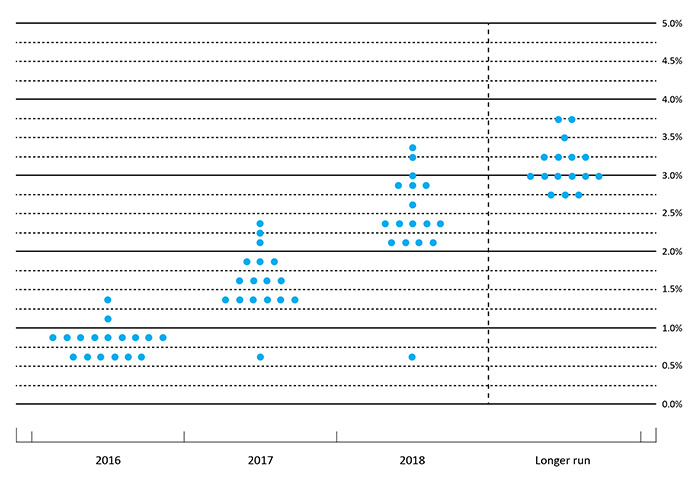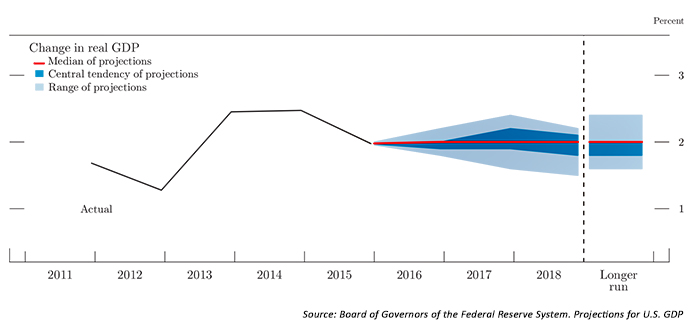
While it was hardly a surprise to markets that the Fed held off on a June rate hike last week, markets appeared to have some level of concern over the relatively downbeat assessment of the global economy given by Federal Reserve Board Chair Yellen.
Further, the “dot plot” developed by the FOMC (based on each committee member’s assessment of the future pace of rate hikes) continues to move in a more dovish direction in response to U.S. economic data, which has been mixed at best.
Said The Wall Street Journal of the latest Fed meeting and press conference:
“The Federal Reserve held short-term interest rates steady and officials lowered projections of how much they’ll raise them in the coming years, signs that persistently slow economic growth and low inflation are forcing the central bank to rethink how fast it can lift borrowing costs. …
“The central bank in December lifted its benchmark federal-funds rate up from near zero to between 0.25% and 0.5%. Officials indicated then they expected to push rates up four times in quarter-percentage-point increments this year to 1.375% at the end of 2016. Instead, their rate target has been unchanged since December and they have cut in half their expectations for rate rises this year. …
“The new projections released Wednesday showed officials expect the fed-funds rate to rise to 0.875% by the end of 2016, according to the median projection of 17 officials. That implies they see two quarter-point rate increases this year, as they did in March. However, a greater number of officials now see just one increase, rather than two moves.”
FOMC ASSESSMENT OF MONETARY POLICY (‘DOT PLOT’)

Source: Original chart titled, “FOMC participants’ assessments of appropriate monetary policy: Midpoint of target range or target level for the federal funds rate.” Economic projections and the target federal funds rate projections made by Federal Open Market Committee participants for the June 14–15, 2016, meeting, Board of Governors of the Federal Reserve System. http://www.federalreserve.gov/monetarypolicy/files/fomcprojtabl20160615.pdf
The scaling back of 2016 interest-rate projections were, according to the official FOMC statement, partially impacted by conflicting factors relative to U.S. economic growth. While “growth in economic activity appears to have picked up,” the statement noted that “business fixed investment has been soft.”
The official outlook for U.S GDP growth certainly points to very modest expectations for the economy over the next several years, as the following chart indicates. Ms. Yellen’s prepared press conference remarks reinforced the committee’s overall concerns:
“Although the financial market stresses that emanated from abroad at the start of this year have eased, vulnerabilities in the global economy remain. In the current environment of sluggish global growth, low inflation, and already very accommodative monetary policy in many advanced economies, investor perceptions of, and appetite for, risk can change abruptly. As our statement notes, we will continue to closely monitor global economic and financial developments.”
ECONOMIC PROJECTIONS, 2016–18 AND LONGER RUN

Source: Original chart titled, “Median, central tendencies, and ranges of economic projections, 2016–18 and over the longer run.” Board of Governors of the Federal Reserve System. Projections for U.S. GDP.
Bespoke Investment Group characterized the FOMC statement and subsequent press conference as “capitulation” on the part of the Fed. They added, regarding the apparent shifting of attitudes by FOMC members over the past few months:
“The Committee’s statement and the contents of the Statement of Economic Projections, which is intended to inform markets about their thinking on the economy, all pointed to a Fed that doesn’t think it can or should raise rates to more than 3% during this economic cycle. … But the communication of policy (especially following recent hawkish language) has us confused and frustrated.”
